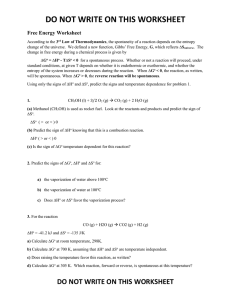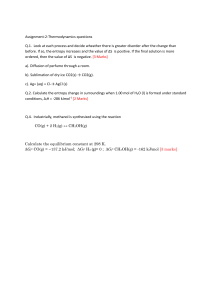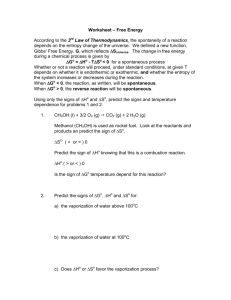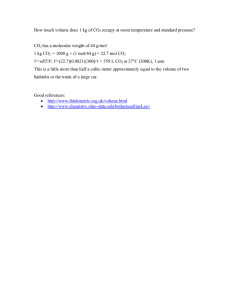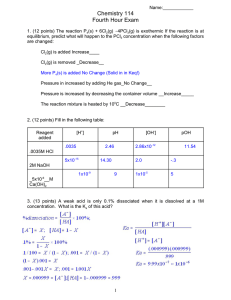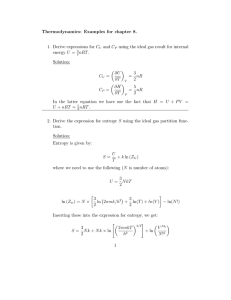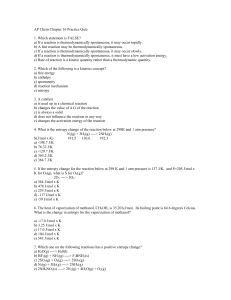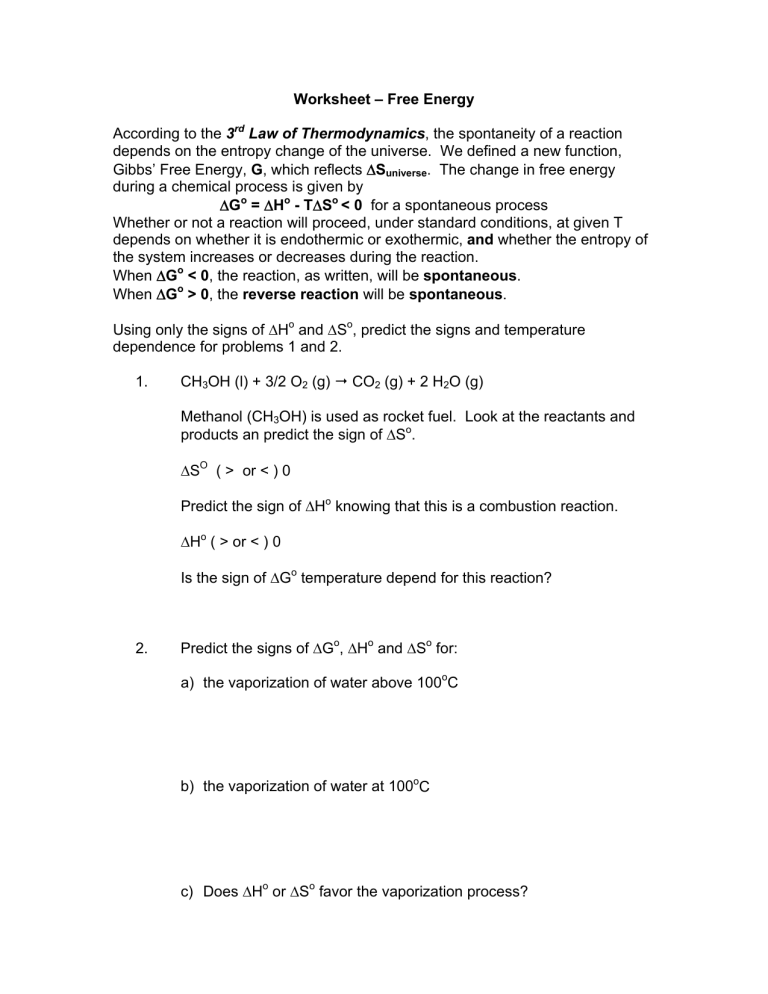
Worksheet – Free Energy According to the 3rd Law of Thermodynamics, the spontaneity of a reaction depends on the entropy change of the universe. We defined a new function, Gibbs’ Free Energy, G, which reflects Suniverse. The change in free energy during a chemical process is given by Go = Ho - TSo < 0 for a spontaneous process Whether or not a reaction will proceed, under standard conditions, at given T depends on whether it is endothermic or exothermic, and whether the entropy of the system increases or decreases during the reaction. When Go < 0, the reaction, as written, will be spontaneous. When Go > 0, the reverse reaction will be spontaneous. Using only the signs of Ho and So, predict the signs and temperature dependence for problems 1 and 2. 1. CH3OH (l) + 3/2 O2 (g) CO2 (g) + 2 H2O (g) Methanol (CH3OH) is used as rocket fuel. Look at the reactants and products an predict the sign of So. SO ( > or < ) 0 Predict the sign of Ho knowing that this is a combustion reaction. Ho ( > or < ) 0 Is the sign of Go temperature depend for this reaction? 2. Predict the signs of Go, Ho and So for: a) the vaporization of water above 100oC b) the vaporization of water at 100oC c) Does Ho or So favor the vaporization process? 3. For the reaction CO (g) + H2O (g) CO2 (g) + H2 (g) Ho = -41.2 kJ and So = -135 J/K a) Calculate Go at room temperature, 298K. b) Calculate Go at 700 K, assuming that Ho and So are temperature independent. c) Does raising the temperature favor this reaction, as written? d) Which factor, entropy or enthalpy, favors this reaction at high and low T? e) Calculate Go at 305 K. Which reaction, forward or reverse, is spontaneous at this temperature? When Go = 0, the system is at equilibrium and both the forward and reverse reaction are proceeding, at the same rate. This is the case during phase transitions. Since Go = 0, Ho = TSo. This can be re-arranged: T = Ho / So which allows the determination of melting or boiling points So = Ho / T which demonstrates that all of the heat added at the transition temperature goes to raise the entropy of the system 4. Calculate the boiling point for BCl3: BCl3 (l) BCl3 (g) given the following information: BCl3 (l) BCl3 (g) 5. Hof (kJ/mol) So (J/mol K) -418 -395 209 290 The heats of combustion of carbon, in the forms of graphite and diamond are shown below. C (gr) + O2 (g) CO2 (g) C(d) + O2 (g) CO2 (g) Ho = -393.5 kJ/mol Ho = -394.4 kJ/mol a) What is the heat of reaction in going from graphite to diamond (hint: use Hess’ Law) C (gr) C (d) b) The absolute entropy of graphite is 5.69 J/mol K and for diamond, 2.44 J/mol K, both at 298 K. Calculate So for this reaction. c) Calculate Go for this reaction. Are diamonds thermodynamically stable at 298 K? The value of Go is related to the equilibrium constant, K, by the expression: Go = - RT ln K 6. What is Go for the following reaction at 298 K? 2 NH3 (g) N2 (g) + 3 H2 (g) Ho = 92.4 kJ So = 198 J/K a) Under standard conditions (1 atm of NH3, N2 and H2) and at 298 K, what will be formed? b) Calculate the equilibrium constant for this reaction at 298 K. c) Calculate the equilibrium temperature for this standard reaction. Will product or reactant be formed above this temperature? 7. For the reaction CO (g) + 2 H2O (g) CO2 (g) + H2 (g) at 770 K, Keq = 5.10. Calculate the Go for the reaction at 770 K.
